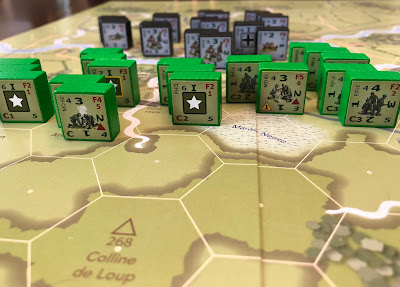 |
| Pictured: Combat Infantry, WestFront 1944-45 by Columbia Games |
“Combat Infantry” was a badge awarded to U.S infantrymen who participated in combat under hostile fire. It’s also a new, fast-paced, World War 2 squad level block game from Columbia Games. From the publisher:
“You command a German or American infantry battalion, composed of three infantry companies and attached heavy weapons including mortars and tanks. Innovative and interactive rules for Fire Combat, Assaults, Morale, and Leaders make this game sophisticated, yet very playable.”The game is comprised of the following components, all reflecting the usual quality people have come to expect from Columbia:
- 2 color geomorphic maps (16.5’’ x 22” each)
- Blocks: 66 green, 66 black
- 22 yellow wooden markers
- Unit Label sheet (1)
- 6 scenarios
- 4 x d10 dice
Those Wooden Blocks
Because Combat Infantry is played with blocks instead of counters or miniatures, it provides two features which add to the realism of gameplay: Fog of war and Step Losses. These upright blocks, labels facing the owner, help to capture the essence of WW2 tactical combat. As is the case with other block games, opponents experience the risk of not knowing which enemy units they will encounter in battle, or how strong they might be.
The Scale of the Game
Combat Infantry includes units for one American and one German Infantry Battalion, as they were on the Western Front in 1944-45. As noted by Columbia, “This was considered the smallest force capable of attacking or defending major objectives.”
Most blocks represent rifle squads of only 9-12 men, approximately 3 men per step. Machine guns, mortar teams, and other heavy weapons are teams of 2-3 men per step. Tanks & artillery are individual crews and vehicles. Compare this with games such as Bobby Lee or Napoléon where infantry blocks are at the brigade level, each step representing approximately 3,000 men. Additionally, each hex in Combat Infantry depicts 100 meters.
 |
| Pictured: Solitaire game of Combat Infantry |
The Structure of Gameplay
Unlike other WW2 games, there are no cards or Combat tables to consult. Movement and battle is generated from command units, either by Company Headquarters (CHQs) or Platoon HQs (PHQs). Additionally, leadership rules require players to maintain platoon integrity (e.g. Company C has platoons C1, C2, and C3, each with their own rifle squads and heavy weapons).
Game turns in Combat Infantry are divided into 8 player turns (4 each), comprised of the following:
- HQ Command, 1 per Company per player turn.
- Commanded units can either Rally, Fire, conduct Special Action (blow up a bridge, etc.), Fire at enemy units in another hex, Move (limited by a block’s movement points & terrain effects), and HQ Action.
- Assault: resolve any and all battles from direct movement into an enemy controlled hex.
Replayability
Combat Infantry provides players with 6 initial scenarios which recreate American and German firefights in the Normandy campaign. Though not based on specific historical battles, they do a good job of simulating squad level fighting in the weeks and months following D-Day. The scenarios range from 4-8 game turns and take anywhere from 2-4 hours to play. Scenario 6 (Last Stand) makes for an excellent introduction to the game. With only 5 turns and 20 blocks per side, it plays fast and benefits from a low block count. The diversity and scope of these scenarios, with the expectation of more to come from the publisher and their fans, means great replayability for Combat Infantry.
Is Combat Infantry for you?
If you are looking for a fast paced WW2 squad level game with strategic depth, Combat Infantry won’t disappoint. I would like to make one suggestion and one observation while wholeheartedly recommending Combat Infantry:
First, play through it several times (and I would suggest several times with scenario W6) before making up your mind about Combat Infantry. I have found my appreciation of the game increasing significantly with each additional play. The pace of the game continues to pick up as well, something that is important to me.
Second, make sure you seek out Combat Infantry forums at BoardGameGeek and on Facebook. While the rules are generally well written, I have found myself confused at times about a few (relatively simple) elements of play. Thankfully I’m apparently not the only one. Columbia Games has even uploaded an FAQs at their site.
Lastly, if you like the game, go review it at BGG. I’m a little surprised by the limited number of ratings it has. This is a well conceived game and it deserves a bigger following than it currently has.
Photo credit: Brian Williams






